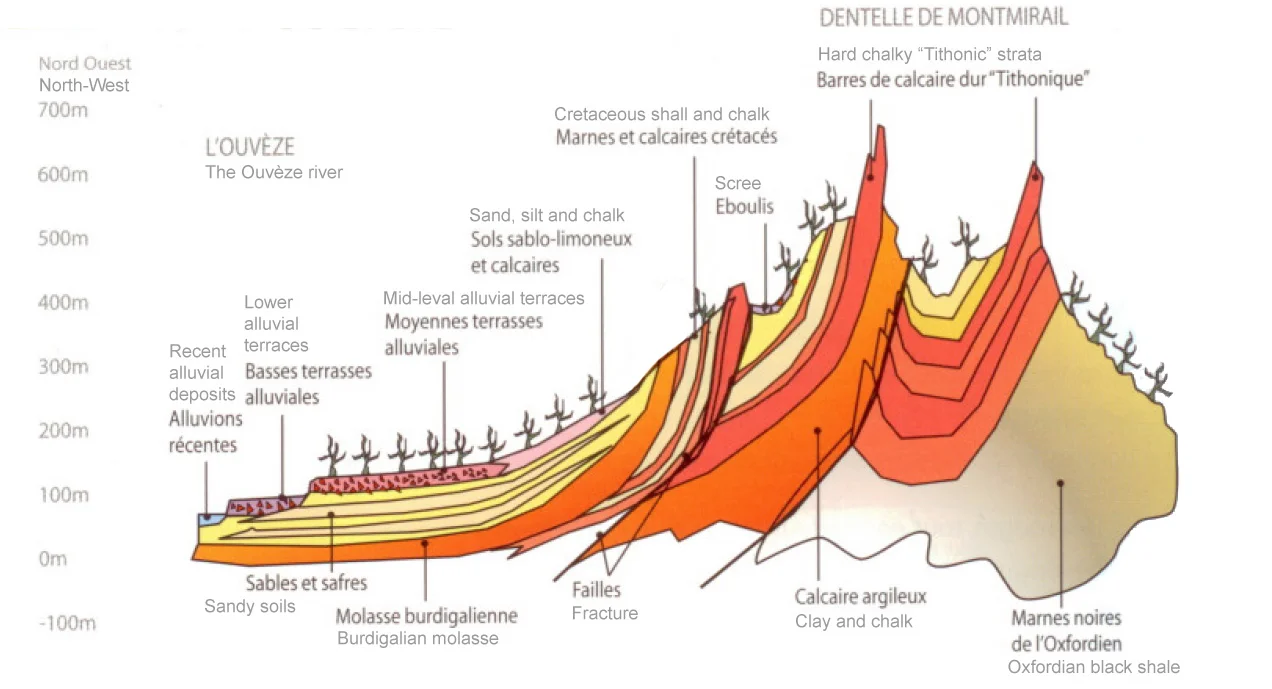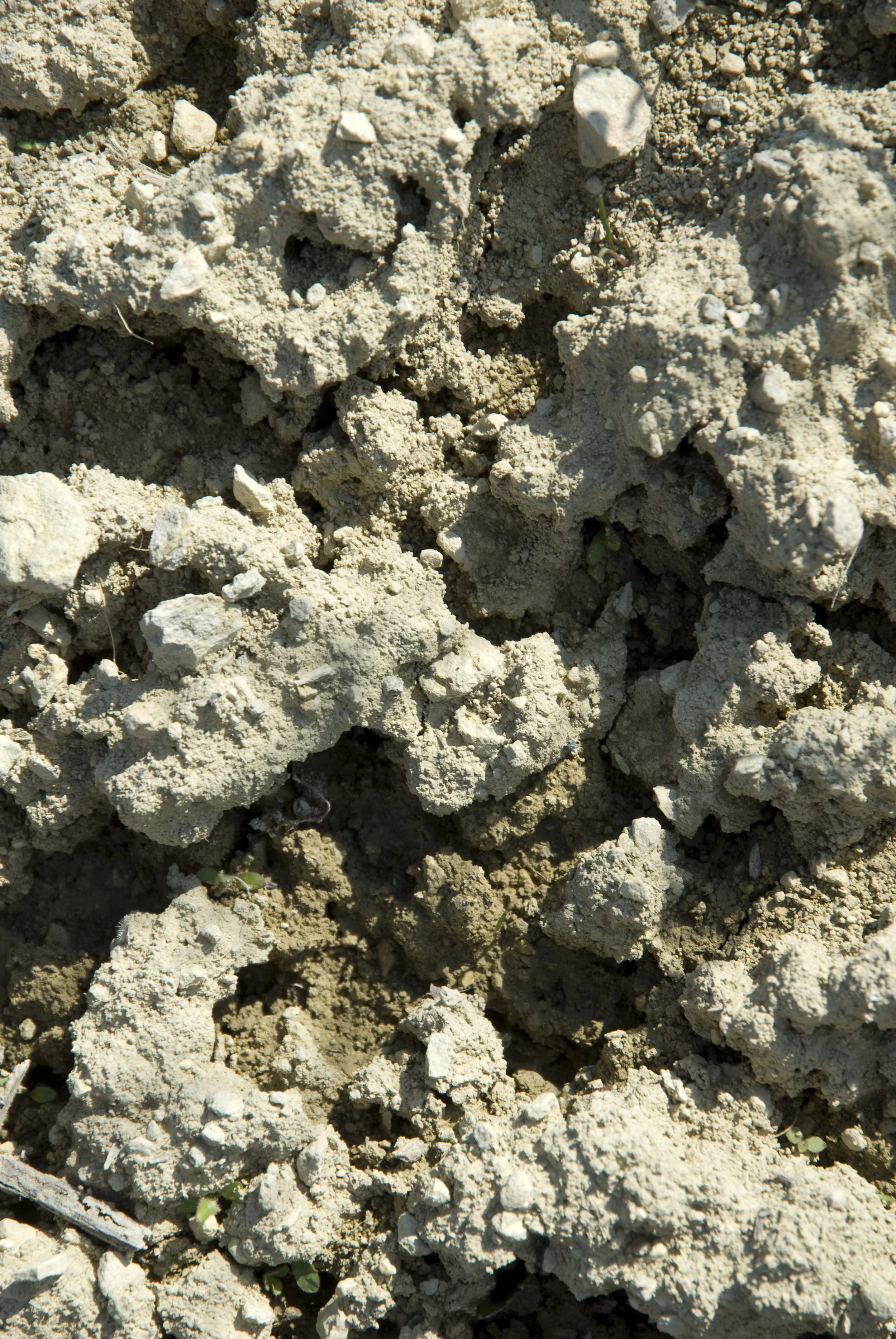THE VINEYARD
Classic Rhône Varieties and Old Vines
Our 30 hectare (75 acre) vineyard is planted predominantly with mature (25yr+) Grenache and (40yr+) Syrah.
Over the last decade we have added smaller quantities of other traditional Rhône varietals such as Roussanne, Marsanne, Viognier, Clairette (whites) and are planting Mourvèdre (red) to complement our classic Rhône base.
THE TERROIR
What is the terroir?
Xavier: We are blessed with a confluence of natural factors. Being so far south, on the same latitude as Gigondas, we have more than 300 sunny days in the year. The fruit ripens deliciously and does not suffer from rot. The vines enjoy regular exposure to the Mistral and other winds that assist in flavor concentration, but our hilly topography spares us from the full force of the blast and the local mini-tornadoes.
What’s so special about your location?
Bénédicte: Our altitude, our isolation and our soil. The altitude (550m/1600ft) gives the variation in temperature between day and night that is essential for fruit quality. Essentially, our grapes ripen more slowly with better flavor development, but the later harvest (up to 3 weeks after our neighbors in the valley) makes them prey to the weather. Fortunately, many years it can work in our favor.
Why is isolation so important?
Xavier: It protects the land from pollution and agricultural hazards which is important when running a vineyard on biodynamic principles. However, all our vineyards are no further than 12 minutes from the winery sorting tables so we can keep the grapes in the finest condition.
What makes the soil so special?
Xavier: The rich mineral content. The distinctive structure of our soil with its basalt content provides a signature to all the Chêne Bleu wines, regardless of varietal or winemaking. The tectonic activity that led to the creation of Mont Ventoux and its foothills has eroded over time, revealing a diverse cross-section of geological strata containing components from the Triassic, Jurassic and Cretaceous periods. The blend creates a very interesting cocktail of minerals. This in turn adds complexity and a mineral signature to all our wines. The topsoil is clay and chalk with plenty of unforgiving, sharp-edged stones.
What is so special about the vegetation?
Xavier: Because we are one of the highest vineyards in Provence, the flora is an interesting mix of highly perfumed Mediterranean and alpine species: lots of wild thyme and rosemary, lavender, various pines and conifers and succulent plants.
THE VITICULTURE
How did you turn around the vineyards?
Xavier: The scraggy, tough old vines were both a blessing and a hindrance. The gnarly toughness makes them ready to withstand extreme conditions, but most had to be retrained. We re-evaluated every single vine, then repicketed and redrew the vineyards to achieve maximum quality and individuality.
What are your current priorities?
Bénédicte: I have a continuing program of replanting, as well as planting new varietals. We changed to the double cordon method, which allows better canopy management and control of sunlight to the fruit. To regenerate the vineyard we like to use the traditional system of massal selection from our old vines - we take cuttings from the best vines, rather than bringing in commercial clones. We aim to select the low yielding vines to give us the quality that comes from concentrated fruit.
Make no mistake; it’s rough, rugged terrain. The work is really back-breaking and the four distinct seasons take their toll. We prune by hand, and pay close attention to the vines throughout the year.
What’s so special about the way you harvest?
Bénédicte: We pick the fruit entirely by hand, placing the whole bunches carefully into shallow crates so that the berries remain whole and keep their ripe juice. We have worked so hard with the grapes all year; we are not going to damage them at the last minute!
What is distinctive about your vineyard?
Bénédicte: We have separated the vineyard into mini-parcelles to capture the identity of each different sector of the soil. I treat each one individually. I dislike synthetic fertilizers and chemicals and use organic treatments such as sheep manure and our own compost as well as sulfur and copper in minimum doses. We use half the usual amount of copper. We are also working towards managing the whole estate in accordance with biodynamic principles.
What is biodynamics all about?
Jean-Louis: Biodynamics is based on the writings of Rudolf Steiner. It’s effectively an approach to managing the soil and the vines in accordance with the influence of the phases of the moon, and it involves treating with something akin to small doses of natural treatments as in homeopathy. All our work in the vineyard is organized around working on agriculturally auspicious days earmarked in the biodynamic calendar.
Do these treatments only apply to the vineyard?
We also follow this calendar in the cellar when racking of the wines – and of course when tasting, if we can. We are always interested in experimenting with natural treatments for the vines, such as one based on propolis from bees in our apiary which we are testing in a selected “parcelle”. It’s all part of our ‘no shortcuts’ philosophy.











